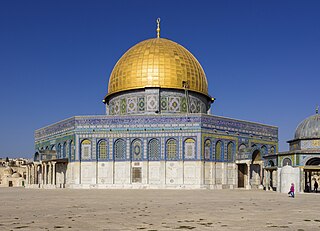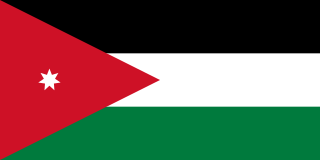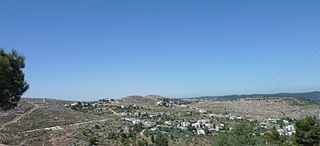Related Research Articles

Palestinians or Palestinian people, also referred to as Palestinian Arabs, are an ethnonational group descending from peoples who have inhabited the region of Palestine over the millennia, and who are today culturally and linguistically Arab.

The Palestinian National Authority, commonly known as the Palestinian Authority and officially the State of Palestine, is the Fatah-controlled government body that exercises partial civil control over West Bank areas "A" and "B" as a consequence of the 1993–1995 Oslo Accords. The Palestinian Authority controlled the Gaza Strip prior to the Palestinian elections of 2006 and the subsequent Gaza conflict between the Fatah and Hamas parties, when it lost control to Hamas; the PA continues to claim the Gaza Strip, although Hamas exercises de facto control. Since January 2013, the Palestinian Authority has used the name "State of Palestine" on official documents, although the United Nations continues to recognize the Palestinian Liberation Organization (PLO) as the "representative of the Palestinian people".

The Palestine Liberation Organization is a Palestinian nationalist political and militant organization founded in 1964 with the initial purpose of establishing Arab unity and statehood over the territory of former Mandatory Palestine, in opposition to the State of Israel. In 1993, alongside the Oslo I Accord, the PLO's aspiration for Arab statehood was revised to be specifically for the Palestinian territories under an Israeli occupation since the 1967 Arab–Israeli War. It is headquartered in the city of Al-Bireh in the West Bank, and is recognized as the sole legitimate representative of the Palestinian people by over 100 countries that it has diplomatic relations with. As the official recognized government of the de jure State of Palestine, it has enjoyed observer status at the United Nations (UN) since 1974. Due to its militant activities, including acts of violence primarily aimed at Israeli civilians, the PLO was designated as a terrorist organization by the United States in 1987, although a later presidential waiver has permitted American contact with the organization since 1988. In 1993, the PLO recognized Israel's right to exist in peace, accepted Resolution 242 of the United Nations Security Council, and rejected "violence and terrorism". In response, Israel officially recognized the PLO as a legitimate authority representing the Palestinian people. However, despite its participation in the Oslo Accords, the PLO continued to employ tactics of violence in the following years, particularly during the Second Intifada of 2000–2005. On 29 October 2018, the Palestinian Central Council suspended the Palestinian recognition of Israel, and subsequently halted all forms of security and economic cooperation with it.

The West Bank is a landlocked territory near the coast of the Mediterranean in Western Asia. It is bordered by Jordan and the Dead Sea to the east and by Israel to the south, west, and north. Under an Israeli military occupation since 1967, its area is split into 165 Palestinian "islands" that are under partial civil administration by the Palestinian National Authority (PNA), and 230 Israeli settlements into which Israeli law is "pipelined". The West Bank's borders also include the lands that comprise East Jerusalem.

The Israeli–Palestinian conflict is one of the world's most enduring conflicts, beginning in the mid-20th century. Various attempts have been made to resolve the conflict as part of the Israeli–Palestinian peace process, alongside other efforts to resolve the broader Arab–Israeli conflict. Public declarations of claims to a Jewish homeland in Palestine, including the First Zionist Congress of 1897 and the Balfour Declaration of 1917, created early tensions in the region. Following World War I, the Mandate for Palestine included a binding obligation for the "establishment in Palestine of a national home for the Jewish people". Tensions grew into open sectarian conflict between Jews and Arabs. The 1947 United Nations Partition Plan for Palestine was never implemented and provoked the 1947–1949 Palestine War. The current Israeli-Palestinian status quo began following Israeli military occupation of the Palestinian territories in the 1967 Six-Day War.

The history of the State of Palestine describes the creation and evolution of the State of Palestine in the West Bank and Gaza Strip.

The First Intifada, or First Palestinian Intifada, was a sustained series of Palestinian protests and violent riots in the West Bank, Gaza Strip, and within Israel. The protests were against the Israeli occupation of the West Bank and Gaza that had begun twenty years prior, in 1967. The intifada lasted from December 1987 until the Madrid Conference in 1991, though some date its conclusion to 1993, with the signing of the Oslo Accords.

The term Palestinian territories has been used to describe the territories of the former British Mandate for Palestine that have been militarily occupied by Israel since the Six-Day War of 1967, namely: the West Bank and the Gaza Strip. The International Court of Justice (ICJ) has referred to the West Bank, including East Jerusalem, as "the Occupied Palestinian Territory" and this term was used as the legal definition by the ICJ in its advisory opinion of July 2004. The term occupied Palestinian territory was used by the United Nations and other international organizations between October 1999 and December 2012 to refer to areas controlled by the Palestinian National Authority, but from 2012, when Palestine was admitted as one of its non-member observer states, the United Nations started using exclusively the name State of Palestine. The European Union (EU) also adopts the term occupied Palestinian territory, with a parallel term Palestinian Authority territories also occasionally used.

The 2000 Camp David Summit was a summit meeting at Camp David between United States president Bill Clinton, Israeli prime minister Ehud Barak and Palestinian Authority chairman Yasser Arafat. The summit took place between 11 and 25 July 2000 and was an effort to end the Israeli–Palestinian conflict. The summit ended without an agreement.

Palestine, officially the State of Palestine, is a de jure sovereign state located in Western Asia. It is officially governed by the Palestine Liberation Organization (PLO) and claims the West Bank and the Gaza Strip. However, its claimed territory has been occupied by Israel since the Six-Day War of 1967. As a result of the Oslo Accords of 1993–1995, the West Bank is currently divided into 165 Palestinian enclaves that are under partial Palestinian National Authority (PNA) rule; the remainder, including 200 Israeli settlements, is under full Israeli control. The Gaza Strip has been ruled by the militant Islamic group Hamas and has been subject to a long-term blockade by Egypt and Israel since 2007.

The Jordanian annexation of the West Bank formally occurred on 24 April 1950, after the 1948 Arab–Israeli War, during which Transjordan occupied territory that had previously been part of Mandatory Palestine and had been earmarked by the UN General Assembly Resolution 181 of 29 November 1947 for an independent Arab state to be established there alongside a Jewish state mainly to its west. During the war, Jordan's Arab Legion took control of territory on the western side of the Jordan River, including the cities of Jericho, Bethlehem, Hebron, Nablus and eastern Jerusalem, including the Old City. Following the end of hostilities, the area that remained under Jordanian control became known as the West Bank.

Land Day, March 30, is a day of commemoration for Arab citizens of Israel and Palestinians of the events of that date in 1976 in Israel.

The Institute for Palestine Studies (IPS) is the oldest independent nonprofit public service research institute in the Arab world. It was established and incorporated in Beirut, Lebanon, in 1963 and has since served as a model for other such institutes in the region. It is the only institute in the world solely concerned with analyzing and documenting Palestinian affairs and the Arab–Israeli conflict. It also publishes scholarly journals and has published over 600 books, monographs, and documentary collections in English, Arabic and French—as well as its renowned quarterly academic journals: Journal of Palestine Studies, Jerusalem Quarterly, and Majallat al-Dirasat al-Filistiniyyah. IPS's Library in Beirut is the largest in the Arab world specializing in Palestinian affairs, the Arab–Israeli conflict, and Judaica.

The Arab–Israeli conflict is an ongoing intercommunal phenomenon involving political tension, military conflicts, and other disputes between Arab countries and Israel, which escalated during the 20th century, but had mostly faded out by the early 21st century. The roots of the Arab–Israeli conflict have been attributed to the support by Arab League member countries for the Palestinians, a fellow League member, in the ongoing Israeli–Palestinian conflict; this in turn has been attributed to the simultaneous rise of Zionism and Arab nationalism towards the end of the 19th century, though the two national movements had not clashed until the 1920s.

Al-Walaja is a Palestinian village in the West Bank, four kilometers northwest of Bethlehem. It is an enclave in the Seam Zone, near the Green Line. Al-Walaja is partly under the jurisdiction of the Bethlehem Governorate and partly of the Jerusalem Municipality. According to the Palestinian Central Bureau of Statistics, the village had a population of 2,041 in 2007, mostly Muslims. It has been called 'the most beautiful village in Palestine'.

The two-state solution to the Israeli–Palestinian conflict envisions an independent State of Palestine alongside the State of Israel, west of the Jordan River. The boundary between the two states is still subject to dispute and negotiation, with Palestinian and Arab leadership insisting on the "1967 borders", which is not accepted by Israel. The territory of the former Mandate Palestine which did not form part of the Palestinian State would continue to be part of Israel.

Nakba Day is the day of commemoration for the Nakba, also known as the Palestinian Catastrophe, which comprised the destruction of Palestinian society and homeland in 1948, and the permanent displacement of a majority of the Palestinian people. It is generally commemorated on 15 May, the Gregorian calendar date of the Israeli Declaration of Independence in 1948. For Palestinians, it is an annual day of commemoration of the displacement that preceded and followed Israel's establishment.

The Israeli occupation of the West Bank began on 7 June 1967, when Israeli forces captured and occupied the territory, then held by Jordan, during the Six-Day War, and continues to the present day. The status of the West Bank as a militarily occupied territory has been affirmed by the International Court of Justice and, with the exception of East Jerusalem, by the Israeli Supreme Court. The official view of the Israeli government is that the laws of belligerent occupation do not apply to the territories, which it claims are "disputed". Considered to be a classic example of an "intractable" conflict, the length of Israel's occupation was already regarded as exceptional after two decades, and is now the longest in modern history. Israel has cited several reasons for retaining the West Bank within its ambit: a claim based on the notion of historic rights to this as a homeland as affirmed in the Balfour Declaration of 1917; security grounds, both internal and external; and the deep symbolic value for Jews of the area occupied.

The Palestinian enclaves are areas in the West Bank designated for Palestinians under a variety of US and Israeli-led proposals to end the Israeli-Palestinian conflict. The enclaves are often compared to the nominally self-governing black homelands created in apartheid-era South Africa, and are therefore referred to as bantustans. They have been referred to figuratively as the Palestinian archipelago, among other terms.
References
- ↑ Miriyam Aouragh, Palestine Online:Transnationalism, Communications and the Reinvention of Identity, I.B.Tauris, 2011 p.164.
- ↑ Hasan Afif El-Hasan, Israel or Palestine? Is the two-state solution already dead?: a political and military history of the Palestinian-Israeli conflict,Algora Publishing, 2011, p.89.
- ↑ Aouragh, Palestine Online, p.90
- ↑ Aouragh, ibid. p.98.
- ↑ Melani McAlister, Epic encounters: culture, media, and U.S. interests in the Middle East since 1945, University of California Press, 2005 p.355.